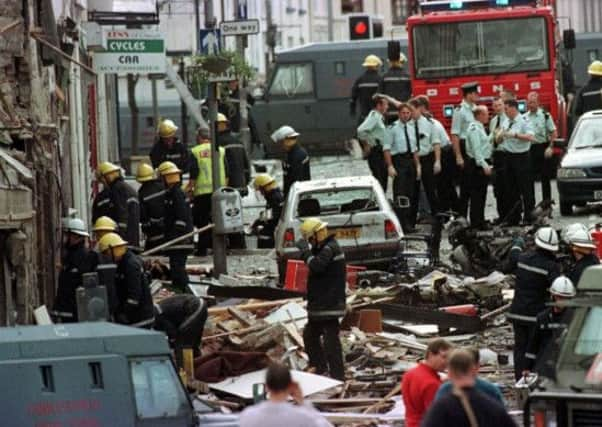Omagh bombing: Report to reveal what police knew


The Real IRA attack in Omagh 16 years ago was the worst single atrocity of the Troubles. The victims included a woman who was pregnant with twins.
Ombudsman Dr Michael Maguire’s investigation into how security force intelligence was disseminated is complete and a report is being compiled, it has emerged.
Advertisement
Hide AdAdvertisement
Hide AdRelatives of those killed when the massive car bomb exploded on a busy shopping street on 15 August, 1998, gathered in the County Tyrone town yesterday for an interdenominational service of remembrance at the memorial garden.
The ombudsman’s office, which independently investigates police work, launched an inquiry after a report by a group of MPs outlined remaining questions surrounding the bombing.
In March 2010, the Northern Ireland affairs committee called for a new investigation into whether intelligence relating to those suspected of the bombing was passed on to detectives investigating it and if not, why not.
The committee also concluded that questions remain about whether the bombing could have been pre-empted by action against terrorists who carried out earlier bombings in 1998.
It also sought a definitive statement on whether the names of those thought to have been involved in the bombing were known to the intelligence services, police special branch or the wider Royal Ulster Constabulary (RUC) in the days immediately after the bombing and if so, why no arrests resulted.
In 2001 former Ombudsman Dame Nuala O’Loan carried out a report on Omagh into the police’s handling of warnings received from an informer. She concluded they would not have been enough to stop the bombing, but checkpoints could have been erected around the town if police had reacted to a separate anonymous call about a planned gun attack.
In April this year a 43-year-old man from the Republic of Ireland was charged with the murders. Seamus Daly, from Culloville, County Monaghan, was arrested by serious crime branch detectives.
No-one has been convicted of murder for the Omagh incident, but relatives of some of the victims brought a landmark civil action against five men they claimed were responsible.
Advertisement
Hide AdAdvertisement
Hide AdFour of the five men were ordered to pay more than £1.5 million in damages to the victims’ families in a civil case.
Families are engaged in a fresh bid for a civil case challenging Northern Ireland Secretary Theresa Villiers’ decision to rule out holding a public inquiry into the case. The matter is due before the High Court in Belfast next month.
Michael Gallagher lost his son Aiden, 21, during the bombing and helped organise yesterday’s service which he believes also recognised the plight of other victims worldwide.
“Particularly this year we have seen an increase in violence around the world with the Malaysian airliner being shot down, the kidnapping of 125 young children by Boko Haram in Nigeria and the trouble in Syria and Iraq,” he said.
Two hurt as republican parade results in only minor trouble
Two people have been injured after a republican parade through Belfast city centre passed with only minor trouble yesterday.
Plastic bottles, fireworks and coins were thrown by a small group of protesting loyalists along the main shopping street but the event was largely peaceful. Police said an officer and a member of the public were slightly hurt.
Unionists were objecting to nationalists marking the anniversary of the introduction of detention of terrorism suspects without trial by the army during the height of the Troubles, still a republican grievance more than 40 years later.
Dozens of riot police wielding shields with batons in holsters formed a barrier between the opposing groups and there were some verbal exchanges. Republicans waved Irish flags and held banners calling for the “End of British Internment” while loyalists clutched Union flags.
Metal security force barricades were erected in the city centre’s side streets.
SEE ALSO